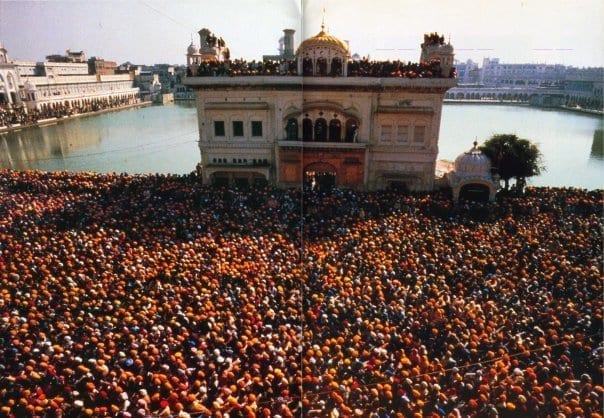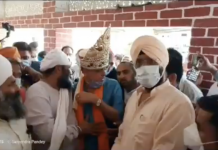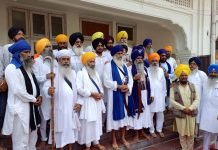


In recent weeks, we have been witness to upheaval in the Khalsa Panth. The Jathedars of the Five Takhts have demonstrated that their decision-making is often guided by external forces rather than by any discernable Sikh principles. The ongoing attacks on Sri Guru Granth Sahib Ji have shown how uninspired the current leadership has been in the face of obvious provocations. External forces are attempting to lure the Panth towards chaos and that is likely where we are headed unless the current opportunity is seized to make much-needed changes in the Panth. The answer to the current challenges is not anger and finger-pointing. The answer to these challenges is inclusive and purposeful action that will seek to bring people together for the collective Chardi Kala of the Panth.
What Changes do we Need?
Before we look at changes, we must clearly identify the defects in the current setup. Without clearly grasping the problems with our current system, we are bound to continue with the same defects in the future. On a Panthik level, the problem is not a single politician. The problem is a system that inherently lends itself to uninspired leadership.
The Shiromani Gurdwara Parbandhak Committee has the largest power in dictating the leadership of the Panth and this appears to be an accident of history rather than an actual decision by the Panth itself. Following the Gurdwara Reform Movement, the control of historically important Gurdwaras was vested to the SGPC by the Gurdwaras Act of 1925. At the time, this was a triumph for the Panth as it vested control of historical Gurdwaras including Harmandir Sahib and Sri Akal Takht Sahib in Sikh hands and away from anti-Sikh forces. In hindsight, the Panth became complacent with a system with many flaws as it was still a marked improvement over the system that it replaced. The SGPC system was flawed for many reasons but most of all because it was a system that was not inspired by Gurbani or Sikh history. It was not an authentically Sikh institution. Its elections have been slowly corrupted and co-opted over time by an Akali Dal Party that has morphed into a secular party with no Sikhi inspiration.
While the current SGPC may be controlled by nominal Sikhs, there is very little that is Gurmat-based about the leadership that it is providing. There is nothing about the status quo that is designed to ensure that Guru-inspired Sikhs are making decisions for the benefit of the Panth and humanity-at-large. The corrupted election process scares off genuine Sikhs and ultimately determines the relatively poor quality of leadership that does emerge. The fact that the SGPC is governed by an Indian government statute highlights how problematic it is. Panthik leadership must free itself from the shackles of political control of federal or state level politicians in India. Lastly, the SGPC is not geographically representative. Many Sikhs living outside of Punjab and in the rest of the world have no way to influence its decision-making. Any future Panthik decision-making process must include all Sikhs from around the world, not just those in Punjab.
An 18th Century Sarbat Khalsa in 2015?
In recent weeks, we have witnessed a clamouring for a Sarbat Khalsa which is supposed to be a gathering of the entire Sikh nation. This has been a positive development insofar as it shows that Sikhs are hungering for an authentically Sikh way to make Panthik decisions to replace the SGPC system. However, a Sarbat Khalsa poses several logistical issues that makes its success unlikely. Sarbat Khalsas were common for much of the 18th Century when the Khalsa Panth was numerically much smaller and divided into Misls which were defined by geographic area. Each Misl had its own leadership and Panthik decisions at the Sarbat Khalsa were made by the leadership of the respective Misls. Today, the population of the Panth is much larger than it was in the 18th Century and more importantly than that, many Sikhs do not neatly fit into a Misl or any other organization for that matter. How are decisions to be made? A Sarbat Khalsa without a system to give voice to all Sikhs is no more authentically Sikh than the current arrangement. For all of the SGPC’s faults, it is at least a relatively orderly system.
The Sarbat Khalsa model was also successful in the 18th Century because leadership that was revered and trusted by the Panth guided the process. The first Sarbat Khalsa was summoned by Bhai Mani Singh and subsequent ones were guided by Gursikhs like Baba Deep Singh, Nawab Kapur Singh and Baba Jassa Singh Ahluwalia. Even in the 1980s, gatherings called “Sarbat Khalsa” (although they did not have the deliberative and inclusive aspects of previous Sarbat Khalsas) were called by the Damdami Taksal or other recognized and largely trusted individuals or organizations. Fast forward to 2015 and there is no such recognized or accepted Sikh leader or organization who has the legitimacy or credibility to call or preside over an inclusive, authentic and functioning Sarbat Khalsa. Furthermore, given the size of the Khalsa Panth today, expecting a one-day Sarbat Khalsa to be functional and legitimate is unrealistic if not delusional.
An unfiltered Sarbat Khalsa is likely to be chaotic and dominated by the angriest amongst us who have the loudest voices. No compelling arrangements have been presented to hear the voices of Sikh women, of the poor, of the so-called low castes and so on. Sikhs from countries outside Punjab also have no clear way of being involved in the process. A Sarbat Khalsa without a thoughtful system in place to hear all voices is more likely to exacerbate problems in the Panth than heal them. A Sarbat Khalsa that has not been adapted for the realities of the 21st Century will be dysfunctional and will lack legitimacy. Without the right system in place, such a “Sarbat Khalsa” may take on the feel of an angry mob rather than the Guru-inspired manifestation of justice and righteousness. Ultimately, decisions will have to be made by Guru-inspired leaders who are chosen by the Panth in an authentically Sikh way. That will be a true Sarbat Khalsa.
Guiding Principles
So what is an authentically Sikh way of choosing Sikh leaders? Rule Number One must be that ultimate authority rests with the Guru. From Sikh history, we know that Sri Guru Gobind Singh Ji made Sri Guru Granth Sahib Ji our living and eternal Guru. All Panthik decision making must be inspired by the Guru. We also know that the Guru, in human form, lies within the Punj Piare. Sri Guru Gobind Singh Ji gave authority for Panthik decision-making to the Punj Piare. Any future Panthik decision-making process must be inspired by the principle of Punj Piare governance. When Baba Banda Singh Bahadur was sent from Nander to Punjab in order to deliver justice to the Mughals, he was accompanied by Punj Piare who had the duty to guide and assist him. The Jathedar of the Panth at that time was under the guidance of the Punj Piare and as a result, the Khalsa was able to overcome insurmountable odds to defeat the Mughals and establish the first Khalsa Raj.
What other rules or guidelines can we glean from Sikh history and/or Gurbani? We would be wise to look at the example of Nawab Kapur Singh. In 1733, Nawab Kapur Singh was chosen by the Khalsa Panth to be its leader. Kapur Singh did not seek a leadership role. He was thrust into it by the will of the Panth. The Panth would be wise to heed this example when choosing leaders in the future. Rule Number Two should be that leadership roles on a Panthik level must not go to those who seek them but rather to those who are nominated based on their history of service and their example as committed Sikhs.
Rule Number Three can simply be that any system for Panthik decision-making must not only be in-line with Sikh traditions but also be practical and feasible in its implementation. This is why an 18th Century Sarbat Khalsa model is unlikely to be suitable for the current day.
A Way Forward
Taking these three rules into consideration, a system for initially selecting Panthik leadership according to Sikh principles can be devised with the following steps:
- Creating a number of geographic zones around the world from which representatives can be chosen. Each zone would have a similar amount of Sikh population living within it. As most of the Sikh population still lives in Punjab, a majority of these zones would be located in Punjab although many zones would be located in other parts of India and indeed throughout the rest of the world. Approximately 50 zones could be created in total in order to keep the process manageable. As an example, the zones outside of India could be divided as follows: Western Canada, Eastern Canada, Western USA, Eastern USA, Northern UK, Southern UK, Continental Europe, Southeast Asia, Australia/NZ and Africa/Middle East. Population differences may exist between the zones but they should be balanced as much as possible in order to make representation as equitable as possible.
- Each representative’s jeevan or way of life must be exemplary and each representative must be of the calibre of doing Amrit Sanchaar Sevaa (as one of the Punj Piare). To be chosen as a representative for a zone, one must be nominated by five Amrit Dhari Gursikhs. Each nominee must be ratified by the Punj Piare at Sri Akal Takht Sahib to ensure that they are an upstanding Panthik Gursikh. This would be a check to ensure the integrity of the process. Specifically, the Punj Piare at the beginning of this process would be the Punj Piare who recently stood up to the decision-making of the current Takht Jathedars. Sikh women must also be a part of this process and should be chosen as representatives when they are the most fitting candidate. A Sikh’s rehit or way or life must be the only consideration; not their gender, not their socioeconomic status and most certainly not their so-called caste.
- Where multiple candidates are nominated from the same geographic zone, a sangat selection meeting will be held at a location in that zone. An invitation would go out to all sangat with at least one month’s notice. During this meeting, Punj Piare would be selected according to Panthik Maryada who would ponder over the qualifications of each nominated individual and make a decision based on which candidate is most fitting.
- Once each zone has picked a representative, all of the representatives would meet together. To get into the right frame of mind, all representatives will engage in Kirtan/Naam Simran/Gurmat Vichaar for several days together. Ultimately, the representatives would pick Punj Piare to guide the leadership of the Panth moving forward. The Punj Piare would have the option of picking a Jathedar from amongst themselves or potentially picking another outside individual to serve as the Panthik Jathedar.
- Moving forward, the Punj Piare and the Jathedar would be responsible for providing thoughtful and purposeful leadership to the Panth in-line with Sikh traditions and principles. At this point, a much more comprehensive system could be designed to replace or update current Sikh institutions.
Now is the time for authentic Sikh leadership to come back to the Khalsa Panth. The Guru has presented their Sikhs with an opportunity and it is our duty to seize it. Seizing the opportunity will require more than a change in institutions. It will require a change in culture as well. A culture of infighting, short-term-thinking and self-destructive behaviour must be replaced by a culture of unity, vision and progress. This change in culture can only happen if, as individuals, we redouble our commitment to the Guru.




